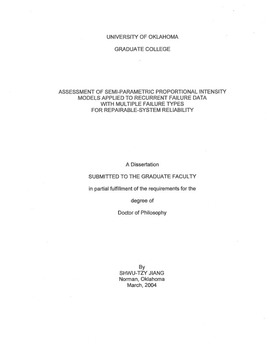| dc.contributor.advisor | Landers, Thomas L., | en_US |
| dc.contributor.author | Jiang, Shwu-tzy. | en_US |
| dc.date.accessioned | 2013-08-16T12:19:18Z | |
| dc.date.available | 2013-08-16T12:19:18Z | |
| dc.date.issued | 2004 | en_US |
| dc.identifier.uri | https://hdl.handle.net/11244/691 | |
| dc.description.abstract | Certain systems experience a substantial period of downtime due to performing maintenance following a major failure. This discontinuity in observation time has been a concern in the accuracy of estimating the covariate effect. Therneau and Hamilton (1997) proposed a discontinuous risk-free-intervals method for biomedical applications that could also apply to this engineering problem. This study has recommended the more favorable engineering applications range. Major and minor failure events are commonly seen in industry, but most researchers have pooled them as though they are identical. Lin (1993, 1994) proposed a covariate PI modeling approach to handle multiple failure types. This study has examined covariate PI modeling as an approach for explicit treatment of two recurrent failure types (major and minor). | en_US |
| dc.description.abstract | The class of semi-parametric proportional intensity (PI) models applies to recurrent failure event modeling for a repairable system with covariates. Abundant federal funding received in biostatistics/medical research has advanced the PI models to become well developed and widely referenced. PI models for medical applications could also apply to recurring failure/repair data in engineering problems. Wider engineering use of these models requires better understanding of applications, performance, and methods to accommodate important situations such as censoring, maintenance intervals, and multiple failure types. | en_US |
| dc.description.abstract | Landers and Soroudi (1991), Qureshi et al. (1994), and Landers et al. (2001) have examined robustness of the Prentice-Williams-Peteson-gap time (PWP-GT) model for the case of an underlying Non-homogeneous Poisson Process (NHPP) with power-law and log-linear intensity functions and complete (uncensored) data. However, the phenomenon of censoring is generally present in field data. This research has extended their work to the important case of right-censorship and has examined other semi-parametric PI models (PWP-total time (PWP-TT), Andersen-Gill (AG), and Wei-Lin-Weissfeld (WLW)). | en_US |
| dc.description.abstract | The PWP-GT and AG models prove to outperform the PWP-TT and WLW models in the robustness studies on right-censoring severity and multiple failure types. The results of examining the PI models in the discontinuous risk-free-intervals modeling indicate that the PWP-GT model performs better in the short overhaul duration. The AG model performs consistently well in the small sample size (20) regardless of the overhaul duration in a HPP case. | en_US |
| dc.format.extent | xvi, 271 leaves : | en_US |
| dc.subject | Engineering, Industrial. | en_US |
| dc.subject | Engineering, Mechanical. | en_US |
| dc.subject | Maintenance. | en_US |
| dc.subject | System failures (Engineering) | en_US |
| dc.subject | Reliability (Engineering) Statistical methods. | en_US |
| dc.title | Assessment of semi-parametric proportional intensity models applied to recurrent failure data with multiple failure types for repairable-system reliability. | en_US |
| dc.type | Thesis | en_US |
| dc.thesis.degree | Ph.D. | en_US |
| dc.thesis.degreeDiscipline | School of Industrial and Systems Engineering | en_US |
| dc.note | Source: Dissertation Abstracts International, Volume: 65-01, Section: B, page: 0384. | en_US |
| dc.note | Adviser: Thomas L. Landers. | en_US |
| ou.identifier | (UMI)AAI3120030 | en_US |
| ou.group | College of Engineering::School of Industrial and Systems Engineering | |
